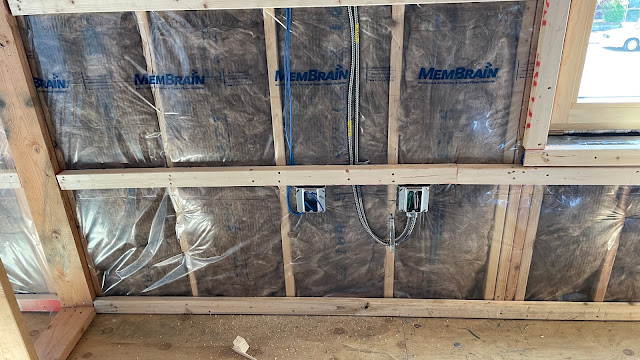USA New Wall – example of Better wall system
categories:
construction issues,
letters from Sweden,
USA New Wall
 Here you see the main wall stud cavity insulated, variable perm vapor control sheet in place, and horizontal furring for the utility cavity in place.
Here you see the main wall stud cavity insulated, variable perm vapor control sheet in place, and horizontal furring for the utility cavity in place.Unfortunately on this job we were not able to source the mineral wool insulation that is my preference due to pandemic related material shortages. We sufficed with partial recycled fiberglass batts by Knauf.
As discussed in past posts, electrical boxes are 4x4x1.5 with reducer covers to fit conventional electrical devices and finish plates. In this case the builder's preference was metal boxes and armored wire due to the institutional nature of the project use, but as you can see there are analogous boxes and reducers in metal as well. Communications and Data low voltage wiring is run similarly in the utility cavity. Certainteed MemBrain variable permeability vapor control sheet seen here is the vapor control layer, and provides the primary air-tightness element in the wall.
Once the utility cavity is insulated following electrical rough-in the exterior walls are ready for drywall. Again lacking availability of mineral wool corresponding fiberglass batts were source, in this instance I believe it was Owens Corning acoustical batts in the 1.5"thickness.
I hope this graphic documentation of a large scale installation is helpful for understanding real world applications of the USA New Wall assemblies. I'm always eager to see your applications of this in your work and would be happy to share them here.







How about "Bonfiglioli strips" instead of the horizontal 2x2. Same principal, just a different take. Drywallers will be more familiar, and their end cuts will be supported. The end of drywall has no paper but the sides do have it so strength is an issue there. Alternative would be to glue drywall scraps behind those end joints for strength
ReplyDeleteWe have seen Swedish house manufacturers that use a Bonfiglioli like assembly - substituting an extremely dense mineral wool spacer over each stud to create a thermal break. It's a valid approach, and simplifies the assembly.
DeleteBut here is the difference - when you use a thermal break like this and a single wythe of cavity batt insulation you lose the opportunity to inset your vapor control sheet, and run wiring inboard. This means you are back to penetrating the vapor control sheet at each switch and outlet box and compromising your air-tightness.
Of course you can manage vapor at the exterior surface, but then you are back to a vapor barrier continuous exterior side insulation of a thickness required to keep in interior surface above dew point. Perhaps it can be done, but it requires analysis to make sure you are not creating a condensation machine. And USA New Wall is about reliable resilient wall systems that builders can adopt with out technical analysis - and to me that means interior side vapor management.
PS I realize that my tile for this post may be misleading for those who have not read my recommendations for Good-Better-Best wall assemblies. The "Best" in my title refers to that tiered system, not making clams of a better wall system.